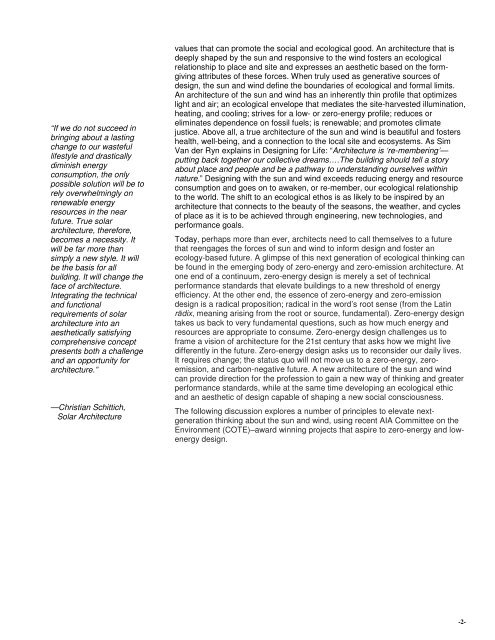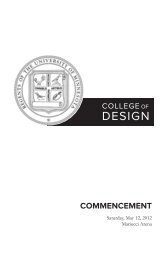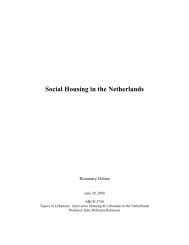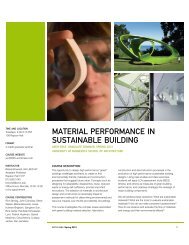THE NEW ARCHITECTURE OF THE SUN AND WIND: - School of ...
THE NEW ARCHITECTURE OF THE SUN AND WIND: - School of ...
THE NEW ARCHITECTURE OF THE SUN AND WIND: - School of ...
Create successful ePaper yourself
Turn your PDF publications into a flip-book with our unique Google optimized e-Paper software.
“If we do not succeed in<br />
bringing about a lasting<br />
change to our wasteful<br />
lifestyle and drastically<br />
diminish energy<br />
consumption, the only<br />
possible solution will be to<br />
rely overwhelmingly on<br />
renewable energy<br />
resources in the near<br />
future. True solar<br />
architecture, therefore,<br />
becomes a necessity. It<br />
will be far more than<br />
simply a new style. It will<br />
be the basis for all<br />
building. It will change the<br />
face <strong>of</strong> architecture.<br />
Integrating the technical<br />
and functional<br />
requirements <strong>of</strong> solar<br />
architecture into an<br />
aesthetically satisfying<br />
comprehensive concept<br />
presents both a challenge<br />
and an opportunity for<br />
architecture.”<br />
—Christian Schittich,<br />
Solar Architecture<br />
values that can promote the social and ecological good. An architecture that is<br />
deeply shaped by the sun and responsive to the wind fosters an ecological<br />
relationship to place and site and expresses an aesthetic based on the formgiving<br />
attributes <strong>of</strong> these forces. When truly used as generative sources <strong>of</strong><br />
design, the sun and wind define the boundaries <strong>of</strong> ecological and formal limits.<br />
An architecture <strong>of</strong> the sun and wind has an inherently thin pr<strong>of</strong>ile that optimizes<br />
light and air; an ecological envelope that mediates the site-harvested illumination,<br />
heating, and cooling; strives for a low- or zero-energy pr<strong>of</strong>ile; reduces or<br />
eliminates dependence on fossil fuels; is renewable; and promotes climate<br />
justice. Above all, a true architecture <strong>of</strong> the sun and wind is beautiful and fosters<br />
health, well-being, and a connection to the local site and ecosystems. As Sim<br />
Van der Ryn explains in Designing for Life: “Architecture is ‘re-membering’—<br />
putting back together our collective dreams….The building should tell a story<br />
about place and people and be a pathway to understanding ourselves within<br />
nature.” Designing with the sun and wind exceeds reducing energy and resource<br />
consumption and goes on to awaken, or re-member, our ecological relationship<br />
to the world. The shift to an ecological ethos is as likely to be inspired by an<br />
architecture that connects to the beauty <strong>of</strong> the seasons, the weather, and cycles<br />
<strong>of</strong> place as it is to be achieved through engineering, new technologies, and<br />
performance goals.<br />
Today, perhaps more than ever, architects need to call themselves to a future<br />
that reengages the forces <strong>of</strong> sun and wind to inform design and foster an<br />
ecology-based future. A glimpse <strong>of</strong> this next generation <strong>of</strong> ecological thinking can<br />
be found in the emerging body <strong>of</strong> zero-energy and zero-emission architecture. At<br />
one end <strong>of</strong> a continuum, zero-energy design is merely a set <strong>of</strong> technical<br />
performance standards that elevate buildings to a new threshold <strong>of</strong> energy<br />
efficiency. At the other end, the essence <strong>of</strong> zero-energy and zero-emission<br />
design is a radical proposition; radical in the word’s root sense (from the Latin<br />
rādix, meaning arising from the root or source, fundamental). Zero-energy design<br />
takes us back to very fundamental questions, such as how much energy and<br />
resources are appropriate to consume. Zero-energy design challenges us to<br />
frame a vision <strong>of</strong> architecture for the 21st century that asks how we might live<br />
differently in the future. Zero-energy design asks us to reconsider our daily lives.<br />
It requires change; the status quo will not move us to a zero-energy, zeroemission,<br />
and carbon-negative future. A new architecture <strong>of</strong> the sun and wind<br />
can provide direction for the pr<strong>of</strong>ession to gain a new way <strong>of</strong> thinking and greater<br />
performance standards, while at the same time developing an ecological ethic<br />
and an aesthetic <strong>of</strong> design capable <strong>of</strong> shaping a new social consciousness.<br />
The following discussion explores a number <strong>of</strong> principles to elevate nextgeneration<br />
thinking about the sun and wind, using recent AIA Committee on the<br />
Environment (COTE)–award winning projects that aspire to zero-energy and lowenergy<br />
design.<br />
-2-







